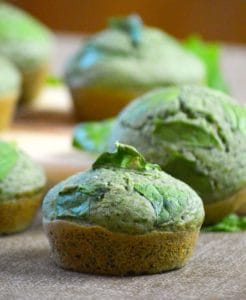
After the summer break, or even after a couple of months back in school, some kids could use a learning boost to re-engage their brains.
Some informal education time in the kitchen can be a big help. Cooking naturally invites the study of art, reading, math, health and science into your home.
Adding a theme to your cooking projects can also encourage the exploration of history, culture and social studies. As your kids enjoy the discovery of new foods and concepts in the kitchen, they will foster a love of learning that can have a positive impact on their studies as a whole.
Following is my allergy-friendly recipe for Herbivore Muffins. When combined with the fun, related teachable moments, this is a great way to get your kids’ brains back into gear for learning.

Herbivore Muffins
Top 9-free, makes 12 muffins
- 2 cups all-purpose gluten-free (or regular all-purpose) flour
- 1/4 cup sugar
- 1 tbsp baking powder
- 1 1/2 tsp cinnamon
- 1/2 tsp baking soda
- 1/4 tsp salt
- 1/2 cup chopped zucchini
- 2 cups packed spinach
- 2 ripe bananas [See Tip]
- 3/4 cup dairy-free milk (or cow’s milk)
- 2 tbsp apple cider vinegar
- 1 tsp vanilla
Instructions for Herbivore Muffins
- Preheat oven to 350 degrees F. Prepare a muffin pan by greasing with oil or butter.
- Mix together flour, sugar, baking powder, cinnamon, baking soda, and salt. Set aside.
- In a blender or food processor, blend and purée the zucchini, spinach, bananas, milk, apple cider vinegar, and vanilla.
- Combine the wet and dry ingredients. For gluten-free flours, mix well. For gluten-containing flours, mix only until just combined.
- Scoop batter into prepared muffin pans.
- Top with fresh spinach leaves as desired.
- Place on center oven rack and bake for 23 to 25 minutes, until a toothpick comes out clean.
- When done baking, remove from oven and let cool in pan for 10 minutes, then remove to wire rack. Enjoy warm or cool. For gluten-free muffins, cool in pan completely.
Tip: The more ripened your bananas, the sweeter these muffins will taste. If yours bananas haven’t ripened enough, there’s a method to help that before making this recipe. Leave the peels on the bananas and spread them out on a cookie sheet. Place in an oven heated to 300 degrees F for 12 to 15 minutes. When you remove, the peels will be blackened and the bananas will be soft and ripe on the inside. Ready for baking!
8 Teachable Moments with Herbivore Muffins

1. What is a herbivore? [Answer: A plant-eating dinosaur]
Explore different types of dinosaurs (carnivore, herbivore and omnivore) or anything else dinosaur-related.
2. Dinosaurs are extinct – or are they?
Research and discover the animals that descended from dinosaurs. [Hint: Look up in the sky!]
3. Plant-Based Eating
Explore the health benefits of plant-based eating and maybe even find some new plant-based recipes to try. You may also choose to research the healthy gut microbiome – and how scientists are finding that good bacteria appear to protect against allergies and asthma.
4. Gluten-Free Baking
Explore the science of gluten-free vs. gluten-containing flours in baking. How does gluten work? As well, it’s interesting to explore why over-mixing gluten-containing flours destroy its effects. On the other hand, extra mixing can create gluten-simulating effects in gluten-free flours.
5. Gluten-Free Eating
Learn the differences between celiac disease and wheat allergy, which grains contain gluten, and various other reasons why some people avoid gluten in their diets.
6. Egg-Baking Science
Explore the purpose of an egg in baking. Which egg substitutes help to provide lift, and which act as a binder? Plus, when do you need one vs. the other or both?
7. Gardening
Zucchini and spinach are both cool weather crops, which means they can be grown in the spring or fall. Start a fall garden and discover other vegetables you can grow in the fall. Learn how and when to plant, water, maintain and harvest these delicious vegetables. Explore the science behind and difference in taste between ripening produce on vs. off the vine.
8. Math
Try doubling or halving the recipe, include learning about measurement conversions (e.g. 3 teaspoons = 1 tablespoon).
Tiffany Rogers is a food allergy mom and founder of the Chef Free Club, an allergy-friendly cooking subscription box service for kids. She’s also the author of a cookie cookbook, and you will find her blog at Allergycookie.com.
Related Reading:
Allergy-Friendly Baking 101: Safe Chocolate Chips, Pantry Essentials
Watching My Little Chef Learn to Bake Without Allergens





